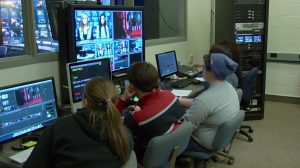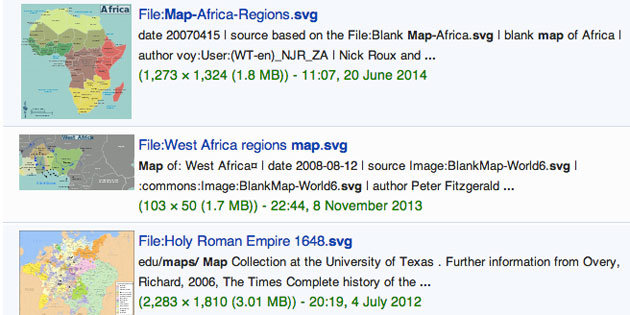Factors to consider when starting a Broadcast Journalism program
 Where do you begin? What do you need to ask for? What do you want to be? Those are major questions. This post is meant to serve as a resource of ideas, best practices, personal opinions and ultimately, a comprehensive guide to prepare you for the journey of beginning a broadcast journalism program. I will say these ideas are not the end all or be all for everyone. Running a broadcast journalism program can look very different for many schools and there many ways to incorporate a multimedia broadcast element. But at its very core, I believe there are a number of basic factors you should consider when starting out.
Where do you begin? What do you need to ask for? What do you want to be? Those are major questions. This post is meant to serve as a resource of ideas, best practices, personal opinions and ultimately, a comprehensive guide to prepare you for the journey of beginning a broadcast journalism program. I will say these ideas are not the end all or be all for everyone. Running a broadcast journalism program can look very different for many schools and there many ways to incorporate a multimedia broadcast element. But at its very core, I believe there are a number of basic factors you should consider when starting out.
What kind of broadcast production/publication do you wish to be?
- Full broadcast class?
- Morning announcements – everyday? Once a week? Twice a week?
- TV studio – do you have one? Do you want to make one? Where do the funds come from?
- Adding raw video to print stories? Mobile journalism?
- TV Magazine show?
- Weekly show?
- Bi-monthly show?
- Monthly show?
- Multimedia short news packages as often as possible?
- Only online distribution? Who hosts your online publications now? How do they manage video?
- Closed Circuit or Cable Access TV? – do you have a local channel that will air your students’ work? If so, how often?
- Longer format documentaries or film? – are you interested in building past simple news packages?
Curriculum
Once you have identified what you want your broadcast production to be, you will need to find the appropriate curriculum. JEA is in the midst of creating modules for your multimedia broadcast needs. Until then, check out Broadcast Journalism skills, objectives, and learning outcomes, Broadcast Journalism resources training and the Academy of Scholastic Broadcasting’s Video Coach. 99% of my students’ learning occurs with online materials and learning by doing. However, if you are more inclined to use a text book, Phil Harris has an excellent one Television Production & Broadcast Journalism.
Video production
I have a few pieces of advice as you begin video production, especially if you have never made a video before. First, allow the students to take the lead. They will learn how to create videos like fish swim in water. It’s true! It’s how their minds work and it’s what they want. Second, personally work on some videos with your students. The best way to learn is by doing. So jump in to create some projects with them as you learn. Third, never allow your students to use popular music, images ripped from Google, or any material that is not their OWN. Copyright law is very real, and as advisers, we need to set the tone and model what is appropriate. If you need royalty-free material, there are a number of free resources on the web. Finally, trust that you do NOT need to be an expert in video production. The skills you and your students will gain over time will improve immensely. Curate great training tools online, attend JEA national conventions or summer Adviser Institutes for professional development, and make the commitment to learn as much as you can about video production.
Live broadcasts
Full disclosure from me here, that we do not broadcast live events as a part of our class curriculum. Our morning newscasts are all student volunteers. Many on our staff are in some level of my broadcast class, but many are not. We open up auditions to the whole school. This process has actually been an excellent recruiting tool for my program. Our Video Technology Coordinator curates the announcements sent in by staff on a daily Google Form. Every other day we have a student video assistant who helps turn on all of the equipment, print schedules, and help with overall set up.
We do not broadcast sporting events. Again full disclosure, I worked on this side of the business for a radio station for three years, so I know first hand the amount of work involved. Besides the intense amount of hours it takes to set up, broadcast, tear down, and post production afterwards, in my opinion, this takes more time than I have to give. In my personal experience, when we attempted this form of broadcasting, we inevitably made certain segments of groups unhappy if we didn’t broadcast their games. Parents began wanting highlight reels of their kids and I believe the amount of time it takes to do all of this, is not equivalent to the value of a true news broadcast journalism curriculum. However, some schools exclusively broadcast live as a part of their curriculum with great success, and they love to create student-athlete highlight reels. So again, you have to decide what type of broadcast program you wish to be.
We do not broadcast music or theater events live. Aside from the copyright issues, this form of video production is incredibly time consuming. A student wishing to earn some extra credit may record these events for archival purposes and for instruction for the particular group that performs. But these recordings cannot be posted or published due to copyright laws. We don’t use the same equipment in our TV studio as we do for these productions, if we do choose to record a performance. However, you could do that. Again, depends on which way you want to go.
Morning news/announcements
I’m not a huge fan of dedicating an entire class to the production of a daily morning news show. If you were to do a weekly, or even a bi-weekly news show, that can work quite well if that’s your set up. That way you can have a live production experience for the kids, while also allowing the students the opportunity to produce short news packages for inclusion into the morning news. Daily news simply doesn’t allow for true journalism.
Actual broadcast
We use a closed circuit cable channel to air our morning news and twice a month for our other production iAm Ladue. Will you have access to a closed circuit channel? If not, does it matter? In my opinion, not really. Use what you can to get your show out there. In fact we have worked really hard on driving traffic to our multimedia site. This could be an easy transition for you to add more video. Again, depends on what you want your broadcast journalism class to be. Ultimately though, it will be paramount to create a Broadcast Production Schedule.
In addition, we decided to do a district communications television show to offer the kids a true full studio, live to tape experience. It’s less journalistic and more broadcast production. However because of this show, our district has consistently provided us additional funds to upgrade our equipment and studio features, which has impacted my entire broadcast program.
TV Studio
Where do you have space? Can you build a full studio? Use an old classroom? Are you getting a new room that you can design? Will you have to use a closet? What can you do for lights? Track lights on the ceiling? Floor lighting kits? What color or backdrop will your studio have? Curtains? Design a set that is built by students? Can you make use of old school furniture? Will you paint the walls? How can you soundproof or create better acoustics in whatever space you have? Much to consider, but my best advice, is use what you can! Get started, then beg and borrow for more space when possible.
Equipment
What kinds of equipment you want will depend on if you want studio equipment, field camera equipment, or both? How will you manage setup, return, checkout, etc.? What will your policies be? The type of program you have will drive the equipment, not the other way around. Two great sources to answer your beginning equipment questions are: Starting from Scratch: Equipment or Broadcast equipment: what do I need?
Funding
How will all of your needs/wants be funded? Upfront? And beyond? Money must be budgeted each school year for repair, replacement, wear and tear, upgrades, new software and technology, training, etc. Come with solutions to the powers that be, not just demands and problems. Create your opportunities for funding resources and you’ll be surprised how the word “yes” may suddenly begin to appear.
Mission/Ethics
Will your program have a mission statement? What will your ethics policy be? What will you stand for? It will be imperative for you and your students to adhere to beliefs and values you feel are important to your community. Formulate these thoughts and ideas with your students so that you have equal buy-in and commitment.
Publication models
A great way to begin your own program is to model what others before you are doing well. Adviser Aaron Manfull and his crew at FHNtoday run the perfect model of a true multimedia site that encompasses articles, photos, video, audience engagement, and much more. Adviser Michael Hernandez and the Mustang Morning News produce bi-weekly news shows that provide their community impressive student journalism. Adviser Matt Rasgorshek and the Westside Wired also produce an excellent multimedia production, as well as broadcast a compilation of their student TV shows for their local Omaha school consortium television channel. And Dave Davis and his crew from HTVBuzz set the gold standard for student broadcasting.
Final thoughts
Scour the JEA Digital Media Broadcast/Video guide for a plethora of ideas and needs for your class and broadcast program and hit up the JEAHELP listserv when a questions arises. Remember, we are always here to help.





Awesome article, Don! (and thanks for the shout out!) I would stress your advice about letting the students take the lead. Once you’ve trained them and set expectations, it IS their show and they should have the power and responsibility to cover what they feel is newsworthy. Thanks for the great insights!
Don,
I’m spearheading the effort to create an LPFM radio station in my little rural hometown of Willits, CA.
I just heard that the School District will consider kicking in some startup funds if we create a curriculum for high school students to learn radio journalism. We want students to have shows that collects and presents local news on a weekly basic.
Do you have a page or two to share that presents the basic of what such a curriculum might cover, and perhaps how to approach it?
A page or two would be sufficient and get us started…
Thanks,
Lanny
Thanks for reading the article Lanny. I don’t do radio, but here is a resource that may help http://writinginstereo.podbean.com.
Its not my first time to go to see this site, i am browsing this website dailly and take pleasant information from
here every day.
You describe the perfect factors when starting a Broadcast Journalism program. Its really a good practice for the purpose to starting a Broadcast Journalism program. You describe briefly steps one by one i extremely like your suggestions.
Thanks so much for providing this information. I am at an elementary school and I wish to improve the productivity of our News Show. I also wonder what would be some great foundational skills at this age, if the students decide to pursue this as a career. Any suggestions would be greatly appreciated.